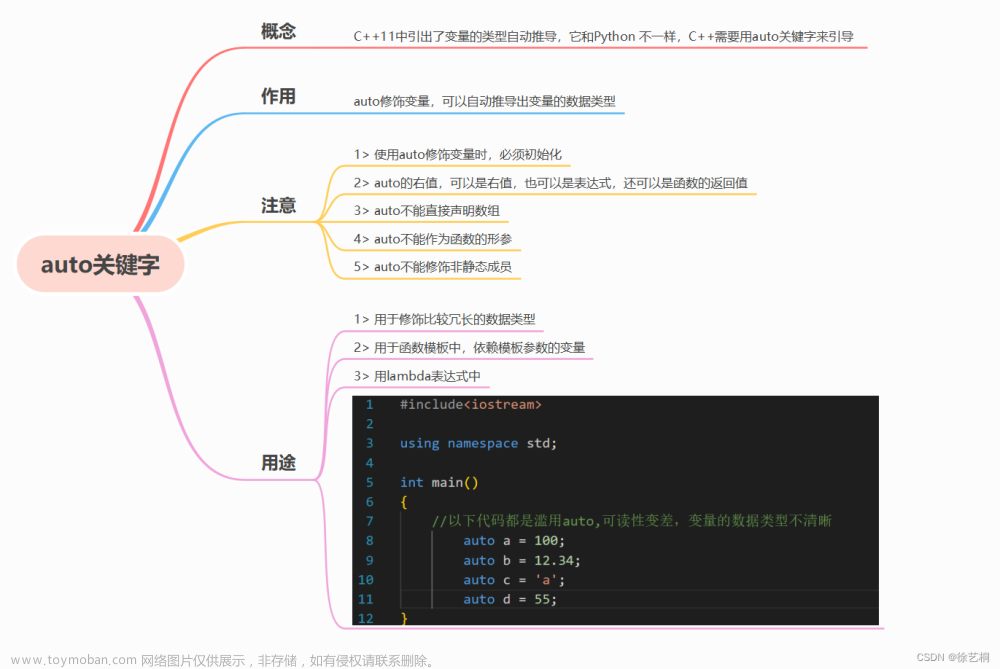定义于头文件 <bitset>
| template< std::size_t N > |
类模板 bitset 表示一个 N 位的固定大小序列。可以用标准逻辑运算符操作位集,并将它与字符串和整数相互转换。
bitset 满足可复制构造 (CopyConstructible) 及可复制赋值 (CopyAssignable) 的要求。
模板形参
| N | - | 要为 bitset 分配存储的位数 |
成员类型
| reference |
表示到一个位的引用的代理类 (类) |
修改器
进行二进制与、或、异或及非
std::bitset<N>::operator&=,|=,^=,~| bitset<N>& operator&=( const bitset<N>& other ); |
(1) | (C++11 前) |
| bitset<N>& operator&=( const bitset<N>& other ) noexcept; |
(C++11 起) | |
| bitset<N>& operator|=( const bitset<N>& other ); |
(2) | (C++11 前) |
| bitset<N>& operator|=( const bitset<N>& other ) noexcept; |
(C++11 起) | |
| bitset<N>& operator^=( const bitset<N>& other ); |
(3) | (C++11 前) |
| bitset<N>& operator^=( const bitset<N>& other ) noexcept; |
(C++11 起) | |
| bitset<N> operator~() const; |
(4) | (C++11 前) |
| bitset<N> operator~() const noexcept; |
(C++11 起) |
行二进制与、或、异或及非。
1) 设置位为 *this 与 other 的位的对应对上二进制与的结果。
2) 设置位为 *this 与 other 的位的对应对上二进制或的结果。
3) 设置位为 *this 与 other 的位的对应对上二进制异或的结果。
4) 返回翻转所有位的 *this 的临时副本(二进制非)。
注意 &= 、 |= 、 和 ^= 仅对拥有相同大小 N 的 bitset 定义。
参数
| other | - | 另一 bitset |
返回值
1-3) *this
4) bitset<N>(*this).flip()
进行二进制左移和右移
std::bitset<N>::operator<<,<<=,>>,>>=| bitset<N> operator<<( std::size_t pos ) const; |
(1) | (C++11 前) |
| bitset<N> operator<<( std::size_t pos ) const noexcept; |
(C++11 起) | |
| bitset<N>& operator<<=( std::size_t pos ); |
(2) | (C++11 前) |
| bitset<N>& operator<<=( std::size_t pos ) noexcept; |
(C++11 起) | |
| bitset<N> operator>>( std::size_t pos ) const; |
(3) | (C++11 前) |
| bitset<N> operator>>( std::size_t pos ) const noexcept; |
(C++11 起) | |
| bitset<N>& operator>>=( std::size_t pos ); |
(4) | (C++11 前) |
| bitset<N>& operator>>=( std::size_t pos ) noexcept; |
(C++11 起) |
进行二进制左移和二进制右移。移入零。
1-2) 进行二进制左移。 (2) 是破坏性的,即对当前对象进行迁移。
3-4) 进行二进制右移。 (4) 是破坏性的,即对当前对象进行迁移。
参数
| pos | - | 移动位的位置数 |
返回值
1,3) 含有被迁移位的新 bitset 对象
2,4) *this
文章来源地址https://www.toymoban.com/news/detail-476366.html
调用示例
#include <iostream>
#include <bitset>
#include <string>
template<size_t _Nb>
void printBitset(const std::string &name, const std::bitset<_Nb> &bitset)
{
std::cout << name << ": ";
for (size_t index = 0; index < bitset.size(); index++)
{
std::cout << bitset[index] << " ";
}
std::cout << std::endl;
}
int main()
{
std::cout << std::boolalpha;
std::bitset<8> bitset1("101010");
std::bitset<8> bitset2("100011");
std::cout << "bitset1: " << bitset1 << std::endl;
std::cout << "bitset2: " << bitset2 << std::endl;
//1) 设置位为 *this 与 other 的位的对应对上二进制与的结果。
std::cout << "bitset1 & bitset2: " << (bitset1 & bitset2) << std::endl;
//2) 设置位为 *this 与 other 的位的对应对上二进制或的结果。
std::cout << "bitset1 | bitset2: " << (bitset1 | bitset2) << std::endl;
//3) 设置位为 *this 与 other 的位的对应对上二进制异或的结果。
std::cout << "bitset1 ^ bitset2: " << (bitset1 ^ bitset2) << std::endl;
//4) 返回翻转所有位的 *this 的临时副本(二进制非)。
std::bitset<8> bitset3 = ~bitset1;
std::cout << "~bitset1: " << bitset3 << std::endl;
std::cout << std::endl;
//进行二进制左移和二进制右移。移入零。
//1-2) 进行二进制左移。 (2) 是破坏性的,即对当前对象进行迁移。
std::bitset<8> bitset5("101010");
std::bitset<8> bitset6 = bitset5 << 3;
std::cout << "bitset5: " << bitset5 << std::endl;
std::cout << "bitset6: " << bitset6 << std::endl;
std::bitset<8> bitset7 = bitset5 <<= 3;
std::cout << "bitset5: " << bitset5 << std::endl;
std::cout << "bitset7: " << bitset7 << std::endl;
//进行二进制左移和二进制右移。移入零。
//3-4) 进行二进制右移。 (4) 是破坏性的,即对当前对象进行迁移。
std::bitset<8> bitset8("101010");
std::bitset<8> bitset9 = bitset8 >> 3;
std::cout << "bitset8: " << bitset5 << std::endl;
std::cout << "bitset9: " << bitset9 << std::endl;
std::bitset<8> bitset10 = bitset8 >>= 3;
std::cout << "bitset8: " << bitset5 << std::endl;
std::cout << "bitset10: " << bitset10 << std::endl;
std::cout << std::endl;
return 0;
}输出
 文章来源:https://www.toymoban.com/news/detail-476366.html
文章来源:https://www.toymoban.com/news/detail-476366.html
到了这里,关于c++11 标准模板(STL)(std::bitset)(四)的文章就介绍完了。如果您还想了解更多内容,请在右上角搜索TOY模板网以前的文章或继续浏览下面的相关文章,希望大家以后多多支持TOY模板网!












